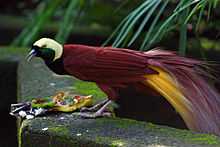Greater bird-of-paradise
| Greater bird-of-paradise | |
|---|---|
 | |
| Male at Bali Bird Park | |
| Conservation status | |
| Scientific classification | |
| Kingdom: | Animalia |
| Phylum: | Chordata |
| Class: | Aves |
| Order: | Passeriformes |
| Family: | Paradisaeidae |
| Genus: | Paradisaea |
| Species: | P. apoda |
| Binomial name | |
| Paradisaea apoda Linnaeus, 1758 | |
The greater bird-of-paradise (Paradisaea apoda) is a bird-of-paradise in the genus Paradisaea.
Carolus Linnaeus named the species Paradisaea apoda, or "legless bird-of-paradise", because early trade-skins to reach Europe were prepared without feet by natives; this led to the misconception that these birds were beautiful visitors from paradise that were kept aloft by their plumes and never touched the earth until death.[2]
Description
The greater bird-of-paradise is the largest member in the genus Paradisaea, with males measuring up to 43 cm (17 in) (excluding the long twin tail wires). The female is smaller, at only 35 cm (14 in). The plumage of this species is also sexually dimorphic. The male has an iridescent green face and a yellow glossed with silver iridescence crown, head and nape. The rest of the body plumage is maroon-brown. The flank plumes, used in displays, are yellow at the base, turning white and streaked with maroon. The female has unbarred maroon brown plumage. In both sexes the iris is yellow and the bills blue.[3]
Distribution
The greater bird-of-paradise is distributed to lowland and hill forests of southwest New Guinea and Aru Islands, Indonesia. The diet consists mainly of fruits, seeds and small insects. A small population was introduced by Sir William Ingram in 1909-1912 to Little Tobago Island of West Indies in an attempt to save the species from extinction due to overhunting for plume trades. The introduced populations survived until at least 1966,[4] but most likely are extinct now.
A common species throughout its native range, the greater bird-of-paradise is evaluated as Least Concern on the IUCN Red List of Threatened Species. It is listed on Appendix II of CITES.
References
- ↑ BirdLife International (2012). "Paradisaea apoda". IUCN Red List of Threatened Species. Version 2013.2. International Union for Conservation of Nature. Retrieved 26 November 2013.
- ↑ Jobling, James A. (1991). A Dictionary of Scientific Bird Names. Oxford: Oxford University Press. pp. 15–16. ISBN 0-19-854634-3.
- ↑ Firth, Clifford B.; Firth, Dawn W. (2009). "Family Paradisaeidae (Birds-of-paradise)". In del Hoyo, Josep; Elliott, Andrew; Christie, David. Handbook of the Birds of the World. Volume 14, Bush-shrikes to Old World Sparrows. Barcelona: Lynx Edicions. pp. 487–488. ISBN 978-84-96553-50-7.
- ↑ Dinsmore, James J. (1970). "Courtship Behavior of the Greater Bird of Paradise". The Auk 87 (2): 305–321. doi:10.2307/4083922.
- The World Atlas of Birds. Galley Press.
External links
| Wikimedia Commons has media related to Paradisaea apoda. |
| Wikispecies has information related to: Paradisaea apoda |
- BirdLife species factsheet for Paradisaea apoda
- Paradisaea apoda on Avibase
- Greater bird-of-paradise videos, photos, and sounds at the Internet Bird Collection
- Greater Bird of Paradise photo gallery at VIREO (Drexel University)
- Interactive range map of Paradisaea apoda at IUCN Red List maps
- Audio recordings of Greater bird-of-paradise on Xeno-canto.
